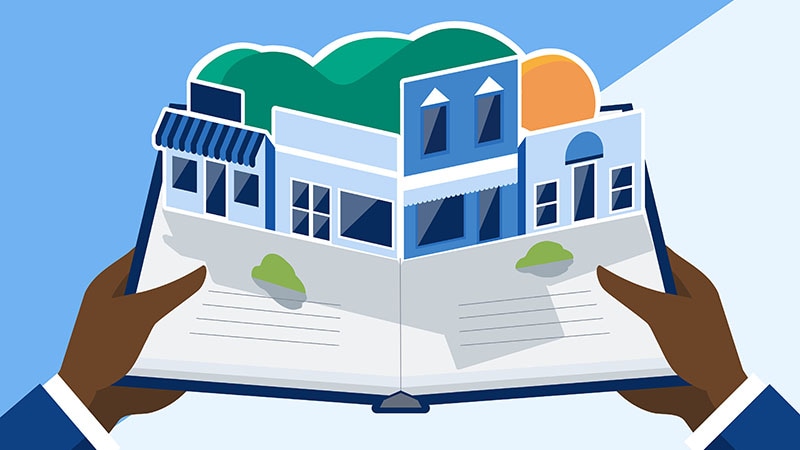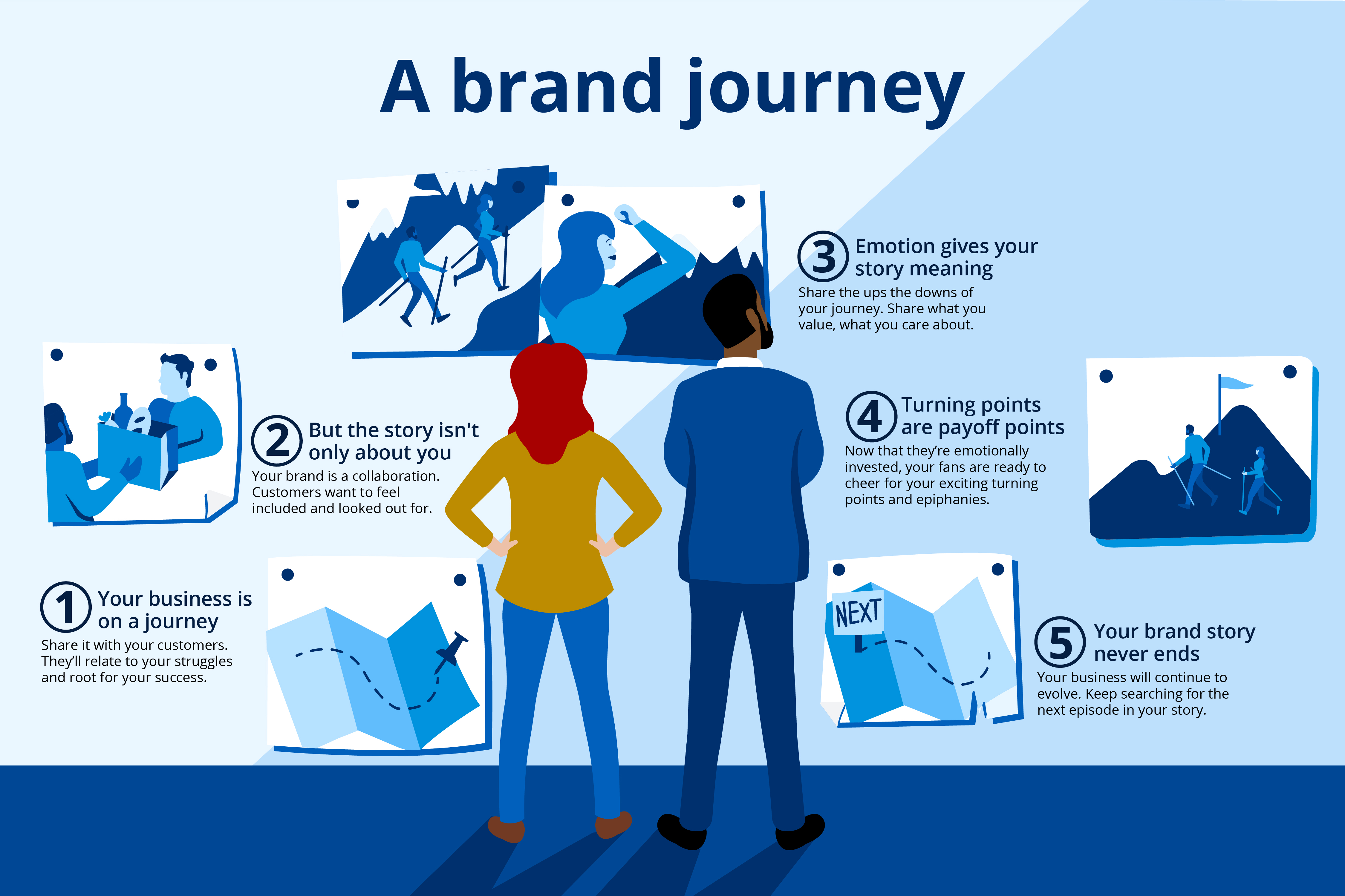The story makes the brand
Your business is off the ground, and now you’re ready to take a more sophisticated approach to marketing. A good place to start is your brand story.

Stories matter. They’re how we understand the world and express our ideas. They bond us to people and communities. They inspire us to act.
We love to listen to stories, but we also tell them constantly. An ordinary moment like grabbing a coffee before a presentation becomes a story when you explain how it made you energized and focused for a business pitch. It’s the story of how you closed the deal thanks to that single cup of coffee.
Every day, your customers tell stories about your brand — to themselves and to the people around them. Your brand story forms the foundation for everything your customers think and feel about your business. That’s why it’s so important that you help shape the story by explaining who you are, what you do and why your customers should care.
Your business is on a journey
Think about the stories you love. Often a character is on a journey. Maybe it’s a physical journey across dangerous landscapes. Or the journey could be personal. The character overcomes doubts or social pressures or a broken heart. By the end of the story, they’ve arrived somewhere new and have been changed by the experience.
Your business is probably on an interesting journey right now. No doubt, you’ve put in a lot of late nights, made sacrifices and ignored the doubters. You’ve followed your heart and developed a vision, and now you’re on your way. People can relate to your struggles and your hopes. They want to root for you because they’ve faced similar challenges and want to believe in your (and their) ability to overcome.
As you write your brand story, think about the arc of your journey.
- How did you get started?
- What kind of world did your business enter?
- Where are you trying to go, and how far have you come?
But the story isn’t only about you
Sure, it’s your business, but your customers aren’t listening to your brand story to pat you on the back and say, “Good job.” They want to hear how it’s about them.
You and your customers are both main characters in this story. You started your business because you are like your customers. You saw a problem that we all experience and thought, “There has to be a better way.” Then you found that way: your business.
Your brand story is about how you’re solving your customers’ problems. It needs to tell them, directly and indirectly, that you understand what they face and are committed to delivering what they need.
Put yourself in your customers’ shoes.
- Why do I care about my customers?
- What role do I play in their lives?
- What do I offer my customers that no one else can?
Emotion gives your story meaning
Narrative is the logical progression of a story: First A happens, then B and finally C. While it’s a critical element of any story, narrative is not the whole story.
A story also needs to make you feel something. It has to have meaning that goes beyond the events or the people. Story is what makes your customers say they love your brand.
So how do you find the emotional core that turns the narrative of your business into a brand story?
Look to your values. Have you written purpose, mission and vision statements? Think about why you love your business. Think about the good you hope it will do for your customers, your community and possibly the world. Your story needs to communicate the bigger ideas behind your business and explain why the journey you and your customers are taking is meaningful.
You also need to be vulnerable. If customers are going to bring your business along on their journey, they need to see you (and your employees) and be seen by you. Start real conversations with your customers about ideas and feelings. Take them behind the scenes, and show them the ups and downs of everyday life at your business. Be open to the reality that your customers tell the story of your brand with you.
Inject emotion into your brand story.
- How can you bring your values into your brand story?
- In what ways can you be vulnerable with your customers?
- What can you do to show your customers that you see them?
Turning points are payoff points
A turning point is where narrative and emotion meet. It’s that moment when everything changes, you see the world differently and you go off in a new direction. These are the moments we love most in stories.
The chemical reactions in our brains during a turning point are fascinating. Early on in a story, as we hear about the people involved, our brains release oxytocin, a chemical that bonds us to other people. Because we care about the people in the story, their struggles cause our brains to release cortisol, a chemical that makes us alert and ready to react to danger. But then the turning point comes and the tension is resolved. Our brains flood with dopamine and we are happy.
Identify your turning points.
- What was the big aha moment at the beginning of your business?
- What breakthrough moments have happened since?
- How has a turning point taken your business on a new path?
- How did a turning point benefit your customers or the community?
Your brand story never ends
When you watch a movie, you expect it to have a beginning, a middle and an end. However, with brands, the story goes on for as long as the business is open — sometimes longer — and it changes as the business changes.
Your values and your commitment to your customers form the solid, unchanging core of your brand story. As you tell your brand story, look ahead and show how you’re always improving your business to benefit your customers.
And don’t forget to keep updating your brand story. Your business will continue to evolve. Make sure your brand story evolves with it.
Tips for writing a compelling brand story.
- Keep it short.
- Take customers on a journey.
- Talk about what matters to you and why it matters to your customers.
- Be vulnerable.
- Find the turning points.
- Keep your story fresh.
What do you do with your story?
A short, simple story about how your business got started, what you do for your customers today and the future you hope to create is a good start. Write it down and put it on your website. But your story is more than the words you use to tell it. Your brand story is part of everything you do.
For example, if your brand story highlights how we need to do something about air pollution, your customers will expect you to walk your talk by using sustainable materials, limiting your carbon footprint and donating to protect air quality. However, if your packaging is mostly plastic and deliveries are made by exhaust-spewing trucks, your brand story will sound false.
The colors you use, how employees interact with customers, your civic activities — everything your business does is a chance to keep telling your brand story. Each customer is on their own journey. Make sure you’re with them step for step.
And this may go without saying, but tell a true story. Honesty and transparency count. A brand story is shared between business and customer. It’s a relationship. And relationships are built on trust.
Once you know your story, look for new ways to tell it
Marketing in a Digital World is an online program that offers tips and insights to help you find your audience, explore your options, elevate your brand and keep learning.




